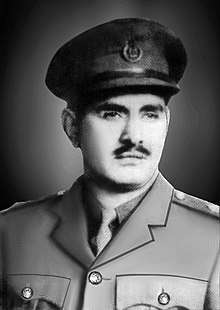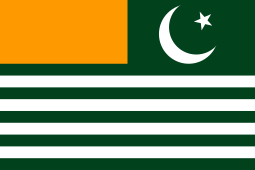Sher Ahmed Khan
Colonel Sher Ahmed Khan (1902 at Pallandri, Poonch, Jammu and Kashmir - 1972) (Now in Sudhnuti, Azad Kashmir), was one of the guerrilla commanders of the Azad Kashmir Movement and also served as the President of Azad Kashmir. He was awarded known as Sher-e-Jang (The Lion of the War) and awarded the Fakhr-i-Kashmir (Proud of Kashmir), which is equivalent to Hilal-i-Jurat.
Fakhr-e-Kashmir
Colonel Sher Ahmed Khan | |
|---|---|
 Colonel Sardar Sher Ahmed Khan in his Army Uniform. | |
| President of Azad Jammu and Kashmir | |
| In office 22 June 1952 – 30 May 1956 | |
| Preceded by | Raja Muhammad Haydar Khan (interim) |
| Succeeded by | Mirwaiz Yusuf Shah |
| Personal details | |
| Born | 1902 Pallandri, Poonch District (now Sudhnuti District), Jammu and Kashmir, British India |
| Died | 23 January 1972 (aged 69–70) Rawalpindi, Pakistan |
| Political party | Military |
Sudhan's uprising against State of Pakistan
A major uprising occurred around the Rawalakot and Pallandri tehsils of Poonch against State of Pakistan; amongst displeased Sudhans, which Ibrahim claimed lasted for seventeen month. After the ‘bomb shell’ of Ibrahim’s dismissal, ‘Colonel (Retired) Sher Ahmed Khan, a sardar and scion of the Sudhan tribe and the senior most military officer from Poonch, was made a cabinet minister with responsibility for defence, education and health. Colonel Sher Ahmed Khan tellingly resigned because ‘his community, the Sudhans, were strongly opposed to his appointment in view of the practical dismissal of their Chief, Sardar Ibrahim Khan, violent demonstrations had occurred particularly in the Rawalakot and Pallandri areas of Poonch, where Sudhans displeased with the sacking their ‘man’, Ibrahim, opposed the replacement government. There also had been show down between the Sudhans and the Pakistan Army contingents posted in the area’, which ‘caused great concern to the Central Government’. The Poonch situation became so bad that the Azad Kashmir Police could not control it. Members of the Punjab Constabulary of Pakistani Army were brought in. The Pakistan Army's 12th Division, with headquarters in Murree and with forces already deployed in Azad Kashmir, joined in the suppression, declaring martial law in Poonch. The fighting was not one sided. Some Sudhans had captured 120 soldiers of Punjab Constabulary, and their arms. Sudhan's anti government actions started in February 1955 with an assassination attempt in Poonch on the Azad Kashmir President, Sher Ahmed Khan, from which he had a ‘miraculous escape’. Matters escalated when police sought to arrest an ‘absconding accused’ by entering a mosque at Pallandri. There after, Sudhans clashed with the Pakistan Army and the Punjab Constabulary, which dealt with the insurrection brutally. Similarly, the Punjab Prosecuting Agency was ‘a terror’ to Azad Kashmiris, particularly those incarcerated. It took 1 year until the uprising was suppressed in 1956.[1]
References
- Snedden, Christopher. Kashmir - The Untold Story. HarperCollins India. pp. 120, 121, 122. ISBN 9789350298985.
